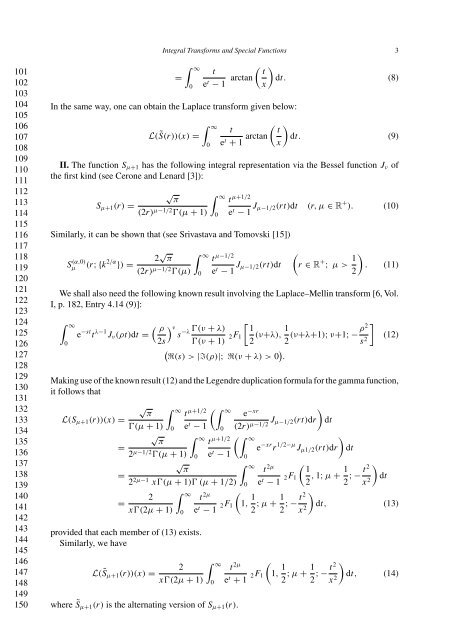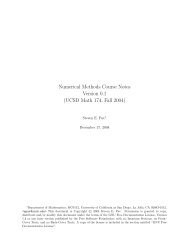Integral representations and integral transforms of some families of ...
Integral representations and integral transforms of some families of ...
Integral representations and integral transforms of some families of ...
Create successful ePaper yourself
Turn your PDF publications into a flip-book with our unique Google optimized e-Paper software.
101<br />
102<br />
103<br />
104<br />
105<br />
106<br />
107<br />
108<br />
109<br />
110<br />
111<br />
112<br />
113<br />
114<br />
115<br />
116<br />
117<br />
118<br />
119<br />
120<br />
121<br />
122<br />
123<br />
124<br />
125<br />
126<br />
127<br />
128<br />
129<br />
130<br />
131<br />
132<br />
133<br />
134<br />
135<br />
136<br />
137<br />
138<br />
139<br />
140<br />
141<br />
142<br />
143<br />
144<br />
145<br />
146<br />
147<br />
148<br />
149<br />
150<br />
<strong>Integral</strong> Transforms <strong>and</strong> Special Functions 3<br />
∫ ∞<br />
( )<br />
t<br />
t<br />
=<br />
0 e t − 1 arctan dt.<br />
x<br />
(8)<br />
In the same way, one can obtain the Laplace transform given below:<br />
∫ ∞<br />
( )<br />
t t<br />
L( ˜S(r))(x) =<br />
e t + 1 arctan dt. (9)<br />
x<br />
0<br />
II. The function S μ+1 has the following <strong>integral</strong> representation via the Bessel function J ν <strong>of</strong><br />
the first kind (see Cerone <strong>and</strong> Lenard [3]):<br />
S μ+1 (r) =<br />
√ ∫ π<br />
∞<br />
t μ+1/2<br />
(2r) μ−1/2 Ɣ(μ + 1) 0 e t − 1 J μ−1/2(rt)dt (r,μ ∈ R + ). (10)<br />
Similarly, it can be shown that (see Srivastava <strong>and</strong> Tomovski [15])<br />
S μ (α,0) (r;{k 2/α 2 √ ∫<br />
π ∞<br />
t μ−1/2<br />
}) =<br />
(2r) μ−1/2 Ɣ(μ) 0 e t − 1 J μ−1/2(rt)dt<br />
(<br />
r ∈ R + ; μ> 1 )<br />
. (11)<br />
2<br />
We shall also need the following known result involving the Laplace–Mellin transform [6, Vol.<br />
I, p. 182, Entry 4.14 (9)]:<br />
∫ ∞<br />
0<br />
( ρ<br />
) [ ν<br />
e −st t λ−1 J ν (ρt)dt = s<br />
−λ<br />
Ɣ(ν + λ) 1<br />
2s Ɣ(ν + 1) 2 F 1<br />
2 (ν+λ), 1 ]<br />
(ν+λ+1); ν+1;−ρ2<br />
2 s 2<br />
( )<br />
R(s) > |I(ρ)|; R(ν + λ) > 0 .<br />
Making use <strong>of</strong> the known result (12) <strong>and</strong> the Legendre duplication formula for the gamma function,<br />
it follows that<br />
√ ∫ π ∞<br />
t μ+1/2 (∫ ∞<br />
e −xr<br />
)<br />
L(S μ+1 (r))(x) =<br />
Ɣ(μ + 1) 0 e t − 1 0 (2r) J μ−1/2(rt)dr dt<br />
μ−1/2<br />
√ ∫ π<br />
∞<br />
t μ+1/2 (∫ ∞<br />
)<br />
=<br />
e −xr r 1/2−μ J<br />
2 μ−1/2 Ɣ(μ + 1) 0 e t μ1/2 (rt)dr dt<br />
− 1 0<br />
√ ∫ π<br />
∞<br />
t 2μ ( 1<br />
=<br />
2 2μ−1 xƔ(μ + 1)Ɣ (μ + 1/2) 0 e t − 1 2 F 1<br />
2 , 1; μ + 1 2 )<br />
2 ;−t dt<br />
x 2<br />
∫<br />
2 ∞<br />
t 2μ (<br />
=<br />
xƔ(2μ + 1) e t − 1 2 F 1 1, 1 2 ; μ + 1 2 )<br />
2 ;−t dt, (13)<br />
x 2<br />
provided that each member <strong>of</strong> (13) exists.<br />
Similarly, we have<br />
L( ˜S μ+1 (r))(x) =<br />
where ˜S μ+1 (r) is the alternating version <strong>of</strong> S μ+1 (r).<br />
0<br />
(12)<br />
∫<br />
2 ∞<br />
t 2μ (<br />
xƔ(2μ + 1) 0 e t + 1 2 F 1 1, 1 2 ; μ + 1 2 )<br />
2 ;−t dt, (14)<br />
x 2














